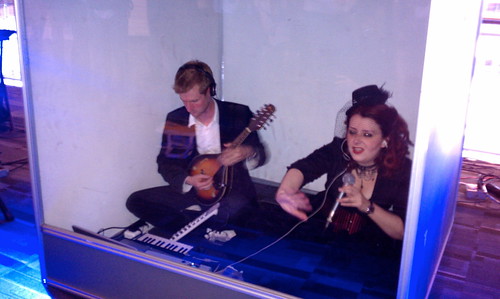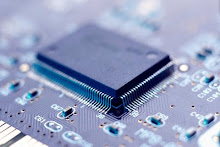CHI 2011, Bill Buxton, and the Buxton Collection: Explore 35 years of interactive devices, online! |
| CHI 2011, Bill Buxton, and the Buxton Collection: Explore 35 years of interactive devices, online! Posted: 18 May 2011 08:54 PM PDT Bill Buxton is a researcher at Microsoft who focuses on Human-Computer Interaction and is known for his work in user experience design and natural user interfaces such as multi-touch surfaces. His talk at the recent CHI 2011 conference, held in Vancouver, Canada, was an overview of the Buxton Collection, an on-line historical archive of interactive input devices spanning over the past 35 years. It was interesting to note that at the time of the presentation, the Vancouver Conference Center, where the conference was taking place, was having serious problems with the network/internet connections, and as a consequence, Buxton was not able to demonstrate the on-line version of his collection as planned. Not to worry. The physical version of the Buxton's archive was on display during the conference, along with Buxton, who was happy to tell the story behind every device and gadget in the archive, with much enthusiasm. The slideshow below provides a glimpse of the Bill Buxton archive displayed at CHI 2011: My Buxton Collection Slideshow, CHI 2011, Vancouver, Canada Buxton's archive of gadgets comes with a rich history, accumulated over the years. Much of this history, until now, has resided in Buxton's head. Holding and touching the items in the archive while listening to Buxton's passionate stories about each one, was unlike anything I had ever experienced. His archive is a labor of love, and the interactive, on-line version of the Buxton Collection is his way of sharing his knowledge with the world. During his talk, Buxton pointed out that in computer science programs, students are not required to have much exposure to the "history of ideas" in the field. Huge chunks of work are often ignored in the literature, and in some cases, the wheel is unknowingly reinvented, and this is something that must be addressed within the CHI community, according to Buxton. I agree. Previous IMT posts about Bill Buxton Bill Buxton's Presentation Video: "A Little Tale about Touch" (Microsoft Worldwide Partner Conference, 2010) Two good articles by Bill Buxton: The Mad Dash Towards Touch Technology; The Long Nose of Innovation Buxton Collection Buxton Collection, PivotViewer Back to the Past: Bill Buxton Shows Off 36 Years of Tech Devices Microsoft News Center, 5/9/11 Microsoft's Bill Buxton exhibits gadget collection 35 years in the making Donald Melanson, engadget, 5/9/11 Bill Buxton's Haptic Input References (pdf) Bill Buxton's website Multi-touch Systems that I Have Known and Loved (Bill Buxton) CES 2010: NUI with Bill Buxton On Engineering and Design: An Open Letter Microsoft Research Principal Scientist Bill Buxton calls for engineers and user experience designers to learn to appreciate one another Bill Buxton, Bloomberg Businessweek, 4/29/09 |
| Posted: 18 May 2011 07:03 PM PDT I had the opportunity to attend the presentation session of humanaquarium: Exploring audience, participation, and interaction at CHI 2011, and also experience humanaquarium's compelling interactive performance along with a crowd of CHI 2011 attendees. It was one of my favorite events.  What I liked about humanaquarium is that it is a good example of how music, the arts, and technology are converging, on many levels. It is encouraging to know that this sort of interdisciplinary, creative collaboration is evident at a number of university research centers. humanaquarium was developed with the support of Culture Lab, Newcastle University (UK), the Advanced Man-Machine Interface Laboratory, University of Alberta, Edmonton, Canada, and the Alberta Foundation for the Arts. According to the abstract for the CHI 2011 paper, "humanaquarium is a movable performance space designed to explore the dialogical relationship between artist and audience. Two musicians perform inside the cube-shaped box, collaborating with participants to co-create an aesthetic audio-visual experience. The front wall of the humanaquarium is a touch-sensitive FTIR window. MaxMSP is used to translate the locations of touches on the window into control data, manipulating the tracking of software synthesizers and audio effects generated in Ableton Live, and influencing a Jitter visualization projected upon the rear wall of the cube." To learn more about humanaquarium and catch a glimpse of the performance, take a look at the following video clips. The first video clip was produced by Nick Barber, who was covering the CHI 2011 conference for IDG News Services. (Nick is also the host and co-producer of World Tech Update.) I produced the second video clip. humaniquarium: Robyn Taylor/Guy Schofield/John Shearer RELATED humanaquarium: exploring audience, participation, and interaction CHI EA '11 Proceedings of the 2011 annual conference extended abstracts on Human Factors in Computing Systems CHI 2011 The User in Flux humanaquarium YouTube channel Humanaquarium blends art and tech, attracts crowds Nick Barber, Computerworld, 5/13/11 Humanaquarium: Two musicians, one box Nate Lanxon, Wired, 3/16/10 |
| You are subscribed to email updates from Interactive Multimedia Technology To stop receiving these emails, you may unsubscribe now. | Email delivery powered by Google |
| Google Inc., 20 West Kinzie, Chicago IL USA 60610 | |




0 comments:
Post a Comment